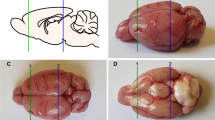Summary
The aim of the study was to examine the effect of antagonists of the NMDA receptor on the parkinsonian-like muscle rigidity in rats. Reserpine and haloperidol increased the muscle resistance of the hind foot to passive movements, as well as the reflex electromyographic (EMG) activity in the gastrocnemius and tibialis anterior muscles. MK-801 (0.32-1.28 mg/kg sc), an uncompetitive antagonist of the NMDA receptor, and L-701,324 (5-40 mg/ kg ip), an antagonist of the glycine site, reduced the muscle tone and the reflex EMG activity enhanced by reserpine or haloperidol. AP-5 (2 and 5 ,μg/ 0.5 pl), a competitive antagonist of the NMDA receptor, and 5,7-dichlorokynurenic acid (1.0-4.5μg/0.5 pl), the glycine site antagonist injected bilaterally into the rostral striatum, inhibited the muscle rigidity induced by haloperidol. In contrast, AP-5, injected alone bilaterally into the intermediate-caudal striatum induced muscle rigidity. The present results suggest that: (1) the inhibitory effect of the NMDA receptor antagonists on the parkinsonian-like muscle rigidity depends, at least partly, on their action on the rostral striatum; (2) the blockade of NMDA receptors in the intermediate-caudal striatum may reduce the beneficial impact of these compounds.
Similar content being viewed by others
References
Carrol CB, Holloway V, Brotchie JM, Mitchell IJ (1995) Neurochemical and behavioural investigations of the NMDA receptor-associated glycine site in the rat striatum: functional implications for treatment of parkinsonian symptoms. Psychopharmacology 119: 55–65
Klockgether T, Turski L (1990) NMDA antagonists potentiate antiparkinsonian actions of L-DOPA in monoamine-depleted rats. Ann Neurol 28: 539–546
Kretschmer BD, Bubser M, Schmidt WJ (1995) Behavioral and neurochemical actions of the strychnine-insensitive glycine receptor antagonist, 7-chlorokynurenate, in rats. Eur J Pharmacol 280: 37–45
Lee RG (1989) Pathophysiology of rigidity and akinesia in Parkinson's disease. Eur Neurol [Suppl 1] 29: 13–18
Lorenc-Koci E, Ossowska K, Wardas J, Wolfarth S (1995) Does reserpine induce parkinsonian rigidity? J Neural Transm [P-D Sect] 9: 211–223
Lorenc-Koci E, Wolfarth S, Ossowska K (1996) Haloperidol-increased muscle tone in rats as a model of parkinsonian rigidity. Exp Brain Res 109: 268–276
Maj J, Rogoz Z, Skuza G, Kotodziejezyk K (1994) Some central effects of kynurenic acid, 7-chlorokynurenic acid, glycine site antagonists. Pol J Pharmacol 46: 115–124
Ossowska K (1994) The role of excitatory amino acids in experimental models of Parkinson's disease. J Neural Transm [P-D Sect] 8: 39–71
Ossowska K, Konieczny J (1996) NMDA receptors in the rostral and intermediate-caudal striatum play an opposite role in regulation of the muscle tone in rats. Pol J Pharmacol 48: 261–267
Ossowska K, Lorenc-Koci E, Wolfarth S (1994) Antiparkinsonian action of MK-801 on the reserpine-induced rigidity: a mechanomyographic analysis. J Neural Transm [P-D Sect] 7: 143–152
Ossowska K, Lorenc-Koci E, Schulze G, Wolfarth S (1996) The influence of dizocilpine (MK-801) on the reserpine-enhanced electromyographic stretch reflex in rats. Neurosci Lett 203: 73–76
Author information
Authors and Affiliations
Rights and permissions
About this article
Cite this article
Ossowska, K., Lorenc-Koci, E., Konieczny, J. et al. The role of striatal glutamate receptors in models of Parkinson's disease. Amino Acids 14, 11–15 (1998). https://doi.org/10.1007/BF01345236
Received:
Accepted:
Issue Date:
DOI: https://doi.org/10.1007/BF01345236



